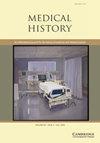Kalle Kananoja, Healing Knowledge in Atlantic Africa: Medical Encounters, 1500–1850 (Cambridge: Cambridge University Press, 2021), pp. xii + 258, $99.99, hardback, ISBN: 9781108491259.
IF 1.1
2区 哲学
Q4 HEALTH CARE SCIENCES & SERVICES
引用次数: 0
Abstract
research on paper as a materia medica, used for example to make plasters, is particularly interesting. Interactions between domestic and scholarly spheres are also considered in SimonWerrett’s essay on the reuse of eighteenth-century wastepaper, including for hairdressing techniques bound up with contested notions of femininity and masculinity. Moving into the modern period, Carla Bittel and Linker both explore how innovative paper tools facilitated bodily knowledge among medical practitioners and patients. Bittel argues that charts studying the human skull enabled phrenologists to construct authoritative, gender-specific identities and simultaneously allowed laypeople to subvert gender stereotypes. The ‘schematograph’ is Linker’s focus; she shows how tracing paper could protect women’s privacy during posture examinations, becoming an instrument of female power within science. Anna Maerker also demonstrates how the materiality of new medical technologies, specifically papier-mâché anatomical models, shaped and challenged gender perceptions. By portraying mechanistic rather than aesthetic bodies, the models both empowered and restricted their female makers and users across different imperial contexts. Another recurring, though more subtle, theme is the link between materiality and morality. Several essays refer to the appropriation of paper technologies by certain communities to claim moral superiority, and socio-political authority, over others. For example, Chapter Four sees Szalay argue that different male groups’ engagement with paper, through intellectual book knowledge, artisanal physical labour and commercial acumen, was central to their competing claims for masculine honour. Serrano’s outstanding contribution explores how a female philanthropic association, the Junta de Damas, asserted power over theMadrid FoundlingHospital through traditionally femininemanagement practices, rather than masculine commercialism. Von Oertzen similarly examines the permeability of the domesticbureaucratic boundary through paper. She explains how domestic data-processing supported nineteenth-century Prussian governance as housewives sorted, counted and organised census cards at home. By emphasising the value of household ‘orderliness’ to the state, this essay foregrounds the relationship between microand macro-level institutions which underpins several other chapters. In conclusion,Working with Papermakes an original and significant contribution to the histories of knowledge, work and gender through the lens of one extremely important material. It is itself a valuable epistemic paper tool for students and experts alike.Kalle Kananoja,大西洋非洲的治疗知识:医学相遇,1500-1850(剑桥:剑桥大学出版社,2021),pp. xii + 258, 99.99美元,精装本,ISBN: 9781108491259。
研究纸张作为一种药材,例如用来制作膏药,是特别有趣的。西蒙·韦雷特在他关于18世纪废纸再利用的文章中也考虑到了家庭和学术领域之间的相互作用,包括与有争议的女性气质和男性气质概念相联系的美发技术。进入现代时期,卡拉·比特尔和林克都探索了创新的纸质工具如何促进医生和病人之间的身体知识。比特尔认为,研究人类头骨的图表使颅相学家能够构建权威的、特定性别的身份,同时也允许外行颠覆性别刻板印象。“图式图”是林克的重点;她展示了描图纸如何在姿势检查中保护女性的隐私,成为科学领域女性力量的工具。Anna Maerker还展示了新医疗技术的重要性,特别是纸质解剖模型,如何塑造和挑战性别观念。通过描绘机械而非审美的身体,这些模型既赋予了女性制造者权力,也限制了她们在不同帝国背景下的女性制造者和使用者。另一个反复出现的主题,虽然更微妙,是物质与道德之间的联系。有几篇文章提到,某些社区利用造纸技术来宣称自己在道德上的优越性和社会政治权威。例如,在第四章中,Szalay认为,不同的男性群体通过知识书本知识、手工体力劳动和商业头脑与纸的接触,是他们争夺男性荣誉的核心。Serrano的杰出贡献探讨了女性慈善协会Junta de Damas如何通过传统的女性管理实践,而不是男性的商业主义,对马德里奠基医院(madrid FoundlingHospital)行使权力。Von Oertzen同样通过纸张考察了国内官僚边界的渗透性。她解释了家庭数据处理是如何支持19世纪普鲁士统治的,因为家庭主妇在家整理、统计和组织人口普查卡。通过强调家庭“有序”对国家的价值,本文强调了微观和宏观层面制度之间的关系,这是其他几个章节的基础。总之,《与纸一起工作》通过一种极其重要的材料,对知识、工作和性别的历史做出了原创而重要的贡献。对于学生和专家来说,它本身就是一个有价值的知识工具。
本文章由计算机程序翻译,如有差异,请以英文原文为准。
求助全文
约1分钟内获得全文
求助全文
来源期刊

Medical History
医学-科学史与科学哲学
CiteScore
1.60
自引率
0.00%
发文量
25
审稿时长
>12 weeks
期刊介绍:
Medical History is a refereed journal devoted to all aspects of the history of medicine and health, with the goal of broadening and deepening the understanding of the field, in the widest sense, by historical studies of the highest quality. It is also the journal of the European Association for the History of Medicine and Health. The membership of the Editorial Board, which includes senior members of the EAHMH, reflects the commitment to the finest international standards in refereeing of submitted papers and the reviewing of books. The journal publishes in English, but welcomes submissions from scholars for whom English is not a first language; language and copy-editing assistance will be provided wherever possible.
 求助内容:
求助内容: 应助结果提醒方式:
应助结果提醒方式:


